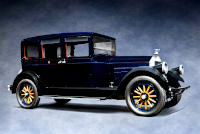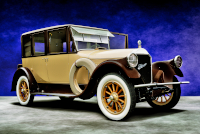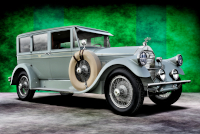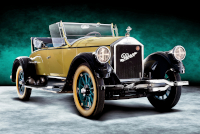Location:
Radnor Hunt Concours d'Elegance, 2007
Owner: Raymond H. Carr | Exton, Pennsylvania
Prologue:
We note the owner of record in 2007, though the car changed hands in 2013.
Sometimes a car falls into the category of interesting for its relationship to its owner, particularly when that story brings local flavor. Though the Model 80 is broadly an important commercial link in Pierce-Arrow's lineage, as a singular artefact, this particular sedan represents a great deal of 20th century action in and around Chester County, Pennsylvania. Chester County is home of the Radnor Hunt Concours where we first took in so many Pierce-Arrow cars so many years ago, (and many more besides). The late Mr. Carr, owner at the time, pursued a great deal of industrial development in Chester County. Insofar as development is often contentious, I should simply say that his influence is as the greater Philadelphia region appears today. That much is 20th century progress. Beyond the suburban landscape, Mr. Carr's stewardship of antique automobiles seems exemplary, at least from what I have read. I try not to paint in rosy colors without considering the bigger picture, but I am happy to have connected this particular car with a broader family of people and projects that appears to have been shared generously. To this extent, chassis #8013205 is a drivers car and a well used antique, nothing so trite as to be collected so much as it is meant to serve the purpose for which it was built.
- - - - - - - - - -
► Image Source: Nikon D200 (10.2 MP)
References:
- Ralston, Marc. "Pierce-Arrow" A.S. Barnes & Co., Inc., San Diego, CA. 1980, page 119-120, 232
- Automobile Quarterly, Volume 28, Number 4, Fourth Quarter 1990, "Change and Prosperity" by John C. Meyer III, The Kutztown Publishing Company, Inc., Kutztown, PA, page 73-74
- Automobile Quarterly, Volume 6, Number 3, Third Quarter 1968, "Pierce-Arrow: An American Aristocrat" by Maurice D. Hendry, The Kutztown Publishing Company, Inc., Kutztown, PA, page 257
- RM Auctions: Chassis #8013205 sold at auction in 2013. RM provides this summary.
- Chicago Vintage Motor Carriage: A 1927 Model 80 Runabout description includes some nice history on the series.
- The Mercury, Pottsville, PA: "Raymond Carr remembered as trailblazing Chester County business developer," by Brian McCullough, first published online February 8, 2015.
Not among the exciting Pierce-Arrow cars, the Model 80 represents a period of survival in which the company diversified (but slightly) into a middle-market luxury automobile. The word "still" can aptly describe its characteristics—still very well built, still adequately powerful, and still relatively expensive.
At the time of its debut in late 1924, Pierce-Arrow produced only the Model 33, the lesser successor of the Model 31. And perhaps least, the Model 80 uses the same aluminum sheet panels over seasoned ash for its body, no longer the innovative cast-aluminum process that made Pierce-Arrow so robust through the otts and teens. The Model 80 also switches the four-valve-per-cylinder T-head motor for a two-valve L-head. In some ways, Pierce-Arrow settled if only to reach the next decade, and the strategy worked. The Model 80 became the most most plentiful of all Pierce-Arrow models and injected much-needed revenue into the company, though the boost proved short-lived.
Automobile Quarterly perfectly summarizes the model's early success: "The entire Series 80 was well thought out and executed in a most simple and logical manner. Easy to drive, it featured outstanding brakes, wonderful steering with a quick turning radius, and a smaller size that was manageable for anyone. Sales for this new luxury owner-driver car were spectacular at first. It was the right product at the right time for an America with an ever-increasing traffic congestion problem and an almost universal cornucopia of newly finished city streets."
Raymond Carr and Chester County Development
The owner of Chassis #8013205 deserves mention, (owner as of the 2007 date of photography). Mr. Raymond Carr, thoughtfully named, served as a driving force in Chester County, Pennsylvania development. The significance of Chester County will resonate with local Pennsylvania folks of the Philadelphia Main Line, which is in fact the location of the Radnor Hunt Concours d'Elegance where we have scoured interesting stories and images since 2006. According to his obituary printed in the Pottstown Mercury, in Chester County Carr "was able to create the last incorporated borough in Pennsylvania," named New Morgan. But most will have come in contact with Carr's work either on a Pennsylvania highway or by means of stopping at a hotel, office, shopping center, restaurant, or tavern. He is very much responsible for industry in these Philadelphia suburbs.
Raymond Carr proved a consummate driver, first and foremost. The Mercury quotes Michael J. Jones, now former AACA President, that Carr "holds two Guinness Book Records for driving the oldest vintage car across the U.S. and the only vintage electric car from coast to coast. He also drove a 1909 steam powered car from Anchorage, Alaska to Bar Harbor, Maine, making him the only person to drive gasoline, electric, and steam powered vehicles across the country." Carr drove endurance rallies across the world, and at home used his cars for enjoyment and events with his family and with the public. In this respect, he seemed to demonstrate a generous attitude about automobile stewardship and the shared pleasure of preserving and using old cars.
Motor: 4,727.7 cc (288.5 cubic inches) "light six" inline 6-cylinder | 88.9 mm x 127 mm (3½" x 5")
Though smaller and simpler than the 4-valve six in the Model 33, this single cast "en bloc" unit retained the same fanatical attention to the balance and honing of its components, and still used composite alloys for the crankcase and camshaft.
Valvetrain: L-head, 2 valves per cylinder
Aspiration: single carburetor
Power: 70 hp @ 2,800 rpm
Taxable 38 hp rating
Drivetrain: 3-speed manual transmission, rear-wheel drive
Pierce-Arrow retired the 4-speed manual in 1919 with the Model 31. The loss of the top-most gear therefore limits top speed.
Front Suspension: semi-elliptic leaf springs with Houdaille shock absorbers, new for the Model 80
Rear Suspension: live axle with three-quarter-elliptic leaf springs and Houdaille shock absorbers
Architecture: steel frame, aluminum panels on northern white ash
Kerb Weight: 2,131.8 kg (4,700 lbs)
Wheelbase: 3,302 mm (130 inches)
Top Speed: 104.6 km/h (65 mph)
Etymology:
The Model 80 is its own project, perhaps the first Pierce-Arrow that is neither successor nor derivation of the original Pierce automobile plan. In turn, its numerical designation is singular, if not completely random. There is no precedent for '80' and no major corresponding technical specification. My best guess is that, by 1924, Pierce had already faced years of pressure from the automotive industry to adopt an 8-cylinder drivetrain, but were never willing to capitulate. While a new model aimed at a middle-market segment would not be the platform to introduce an eight, the Model 80 would eventually serve as the basis for the first Pierce-Arrow 8-cylinder. This form of motor development, up-rating a 6-cylinder to an 8-cylinder, is wholly conventional, and yet had not been Pierce-Arrow's modus operandi since their move to six cylinders in 1907. So perhaps what we see in the Model 80 is an aspiration to meet popular demand, if not for the Pierce philosophy, then for survival. It's as though Pierce-Arrow said, "We want a popular car, and '8' is a popular number. We'll go with that."
Figures:
Marc Ralston notes that no records confirm the exact number of Model 80 cars built, estimating 7,500 units in 1926.
Value:
Chassis #8013205 sold at RM's Hershey auction in 2013 for $44,000.
Tip-Top: Stature and Shape of the Pierce-Arrow Model 80
The Model 80 differs from the greater Model 33 most notably in its vertical windscreen, simpler than the enclosed-drive style of the Model 33. Tyre size reduces from 33 inches to 32 inches, and the wheelbase trims a full eight inches down to 130, which produces more compact proportions. These changes support Automobile Quarterly's description of a more manageable car, absolute counterpoint to the mammoth proposition that was the Model 66, the high-performance attitude of the Model 51, or the stateliness of the old Model 48. Pierce-Arrow is indeed a different auto-maker in the 1920s. In period, the sedan shape is not terribly different than the larger, more powerful Model 33, and not dissimilar than an industry standard rectilinear design.
No longer a cast-aluminum body, the simpler aluminum panel construction lowered base cost, but conversely opened up the possibility for custom coachwork on a Pierce-Arrow chassis. The revolutionary process by which Pierce-Arrow built its cars generally precluded tampering by coachbuilders, a situation not unlike the contemporary Lancia in Italy, whose monocoque chassis was not suited for body-on-frame customization. So like Lancia, as Pierce-Arrow matured, the product became simpler, and therefore amenable to external interpretations. Perhaps the Pierce-Arrow essence is diluted in this respect, but the company's shift away from their rigorous design philosophy is necessary to match the custom coachbuilding trend that will define luxury automobiles in the classic era.
Brand Notions: Dawley Lights and Mascots in the 1920s
The Dawley integrated headlamps alert onlookers to the Pierce-Arrow brand, indicating the engineering quality underneath. When seen in 2007, chassis #8013205 wore eyebrows on its headlamps; these disappeared by the time the car went to auction in 2013. This particular Model 80 also dons the Pierce-Arrow archer mascot, though it cannot be original to the car, which is two years older than the first famous archer. This mascot appears to be a late version as it lacks the helmet and clothes first seen on the 1928 casting, which would have been a bit more appropriate. Judging by the posture, the mascot likely dates to about 1931.
Last Updated: Mar 26, 2025







